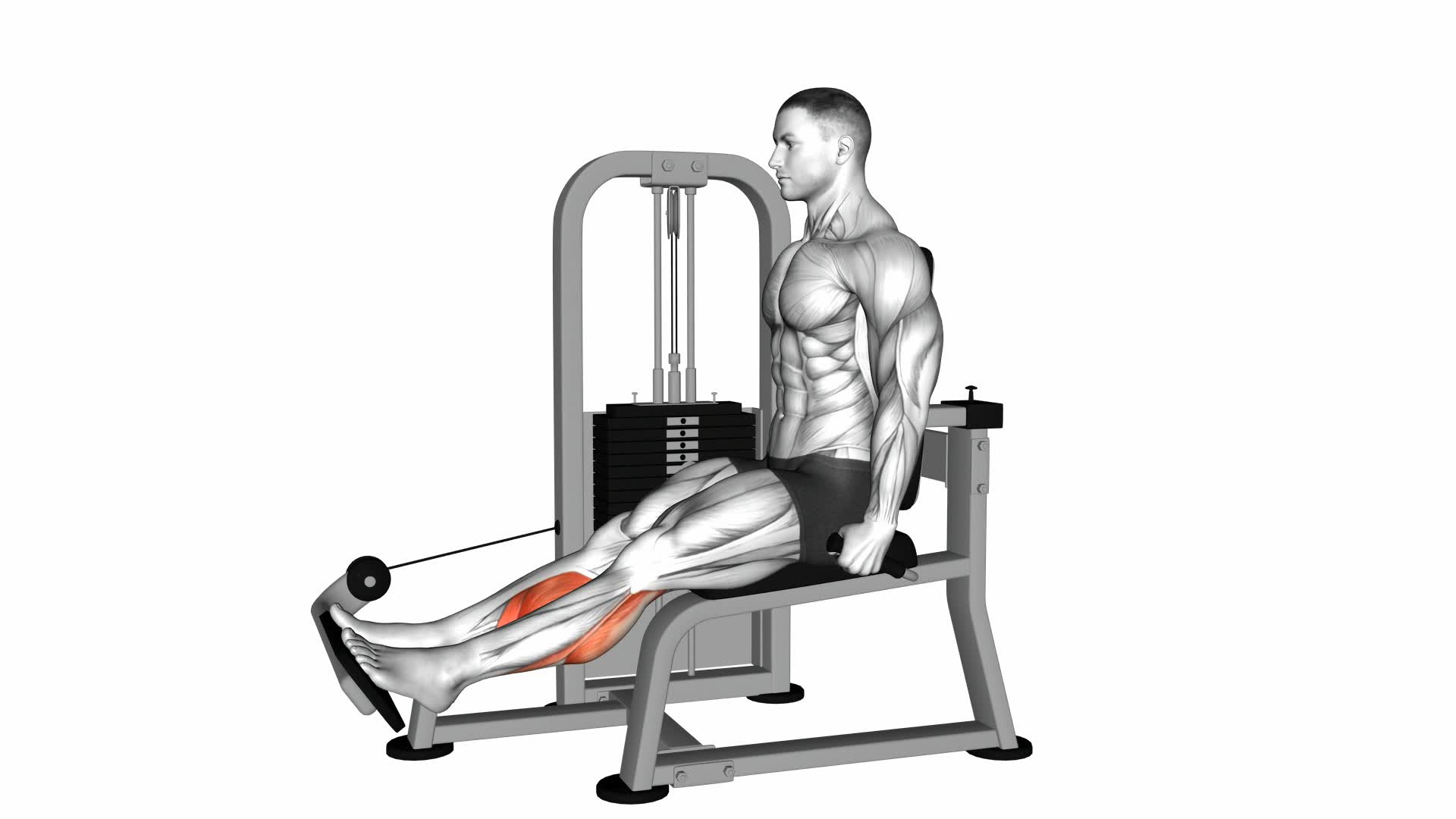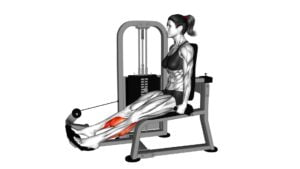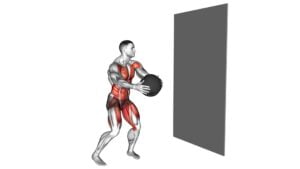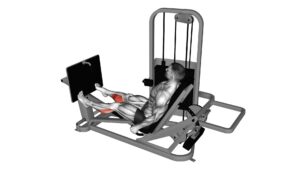Lever Rotary Calf – Video Exercise Guide & Tips

Are you looking for an effective exercise to strengthen and tone your calf muscles? Look no further than the Lever Rotary Calf exercise!
Watch This Exercise Video
In this video exercise guide, we will show you the proper technique, common mistakes to avoid, and tips for increasing intensity. Whether you're a beginner or advanced, this exercise is suitable for all fitness levels.
Get ready to sculpt your calves and achieve your fitness goals with this simple yet powerful exercise.
Key Takeaways
- Lever rotary calf exercise strengthens calf muscles for jumping, running, and explosive movements.
- It improves power, agility, balance, and stability in the lower body for sports like basketball, soccer, and track and field.
- Lever rotary calf exercise enhances overall lower body strength and muscle tone.
- Proper form, gradual progression, and safety precautions are essential for effective and safe execution of the exercise.
Benefits of Lever Rotary Calf Exercise
Discover the benefits you can gain from incorporating the Lever Rotary Calf exercise into your fitness routine. Lever rotary calf exercise variations offer numerous advantages, especially for athletes.
One major benefit is the strengthening of your calf muscles, which are essential for activities that involve jumping, running, and explosive movements. By targeting the calves specifically, you can increase power and agility in your lower body, improving performance in sports like basketball, soccer, and track and field.
Additionally, lever rotary calf exercises help to improve balance and stability. Strong calf muscles provide a stable foundation for your body, reducing the risk of ankle sprains and other lower body injuries. This is especially important for athletes who frequently engage in high-impact activities.
Furthermore, incorporating calf exercises into your routine can enhance overall lower body strength and muscle tone. Well-developed calves can contribute to a more aesthetically pleasing physique while also providing functional benefits in everyday movements such as walking and climbing stairs.
As we explore the equipment needed for lever rotary calf exercises, you'll discover how to properly perform this exercise for maximum benefits.
Equipment Needed for Lever Rotary Calf Exercise
You will need some equipment to perform the Lever Rotary Calf exercise. The main piece of equipment required is a lever rotary calf machine, which can usually be found in most gyms. This machine consists of a padded lever that you'll place your shoulders against, and a foot platform with a weight stack.
When using the lever rotary calf machine, it's important to pay attention to your foot placement and weight distribution. Start by positioning your feet on the foot platform, making sure that the balls of your feet are securely planted. Your heels should be hanging off the edge of the platform. This position allows for a full range of motion during the exercise.
In terms of weight distribution, aim to evenly distribute your body weight on both feet. This will ensure that you're engaging both calves equally and avoiding any imbalances.
Now that you know what equipment you need and how to position your feet and distribute your weight, you can move on to learning the proper technique for the Lever Rotary Calf exercise.
Proper Technique for Lever Rotary Calf Exercise
To perform the Lever Rotary Calf exercise with proper technique, follow these steps to ensure you're doing it correctly:
- Position yourself: Start by sitting on the machine with your knees bent and your feet resting on the foot platform. Adjust the knee pad so that it comfortably rests on your thighs.
- Execution: Push the foot platform downward, extending your ankles as much as possible. Feel the stretch in your calf muscles as you lower the weight. Then, slowly return to the starting position.
- Proper breathing technique: Inhale as you lower the weight and exhale as you push the foot platform back up. This will help you maintain control throughout the movement.
- Recommended sets and reps: Aim for 3 to 4 sets of 10 to 12 repetitions. Start with a weight that challenges you but allows you to maintain proper form. Gradually increase the weight as you become stronger.
Common Mistakes to Avoid During Lever Rotary Calf Exercise
When performing the lever rotary calf exercise, it's important to pay attention to proper foot positioning. Make sure your feet are aligned with the lever and not turned inward or outward, as this can result in incorrect muscle activation.
Additionally, avoid using excessive weight that may compromise your form and increase the risk of injury.
Proper Foot Positioning
Ensure proper foot positioning to avoid common mistakes during the Lever Rotary Calf exercise. Proper foot placement and ankle stability are crucial for maximizing the effectiveness of this exercise. Here are some important tips to keep in mind:
- Align your feet: Place your feet shoulder-width apart on the platform, ensuring that they're parallel to each other. This will provide a stable base for the exercise.
- Maintain ankle stability: Keep your ankles in a neutral position throughout the exercise. Avoid rolling them inwards or outwards, as this can lead to instability and potential injury.
- Distribute weight evenly: Make sure to distribute your weight evenly on both feet. This will help engage the calf muscles evenly and prevent strain on one side.
- Avoid excessive toe pointing: While it's natural for your toes to point slightly downwards during the exercise, avoid excessive toe pointing as it can put unnecessary strain on the calf muscles.
Avoiding Excessive Weight
Keep your weight manageable to avoid overloading the calf muscles during the Lever Rotary Calf exercise. Avoiding excessive weight is crucial to prevent injury and ensure an effective workout. Overloading the calf muscles can lead to strains, sprains, or even muscle tears.
To avoid these risks, start with a proper warm-up routine that includes dynamic stretches and light cardio exercises. This will help increase blood flow and warm up the muscles, preparing them for the exercise. Gradually increase the weight you use for the Lever Rotary Calf exercise, focusing on maintaining proper form and technique. Remember, it's better to start with a lighter weight and gradually progress rather than jumping to heavier weights right away.
By keeping your weight manageable and following proper warm-up techniques, you can avoid injury and maximize the benefits of the Lever Rotary Calf exercise.
Now let's move on to maintaining proper form.
Maintaining Proper Form
To maintain proper form during the Lever Rotary Calf exercise, it's important to focus on your positioning and avoid common mistakes that can compromise the effectiveness of the workout. Here are some tips to help you maintain balance and get the most out of your stretching exercises:
- Keep your feet flat on the foot platform throughout the movement. This will ensure that your calves are properly engaged and prevent your heels from lifting off prematurely.
- Maintain a neutral spine by keeping your back straight and your chest up. Avoid hunching forward or rounding your shoulders, as this can put unnecessary strain on your lower back.
- Control the movement by using a slow and controlled tempo. Avoid using momentum to swing the weight up and down, as this can reduce the effectiveness of the exercise.
- Focus on the stretch at the bottom of the movement by fully extending your calves and holding the position for a brief moment. This will help to improve flexibility and range of motion in your calf muscles.
Tips for Increasing Intensity and Progression in Lever Rotary Calf Exercise
To maximize the effectiveness of the Lever Rotary Calf exercise, gradually add weight to the machine as you progress. Increasing the resistance will challenge your calf muscles and help you build strength and endurance. Start with a weight that you can comfortably handle and aim to increase it by 5-10% each week. This gradual increase will allow your muscles to adapt and grow stronger over time.
In addition to adding weight, you can also incorporate alternative exercises to further enhance the intensity of your calf workout. One option is to perform standing calf raises on a raised platform, such as a step or a block. This exercise requires more stability and engages additional muscles in your lower legs.
Another alternative is to perform single-leg calf raises, which isolate each calf muscle individually. This can help address any muscle imbalances and promote more symmetrical development. To perform this exercise, simply lift one leg off the ground and perform the calf raise on the opposite leg.
Remember to listen to your body and progress at a pace that's comfortable for you. Pushing yourself too hard too soon can lead to injury.
Now, let's move on to the precautions and safety tips for the lever rotary calf exercise.
Precautions and Safety Tips for Lever Rotary Calf Exercise
Before you start the lever rotary calf exercise, it's important to understand proper form demonstration to ensure you're performing the exercise correctly.
Additionally, knowing common mistakes to avoid can help prevent injuries and maximize the effectiveness of the exercise.
Lastly, familiarize yourself with equipment safety guidelines to ensure a safe workout environment.
Proper Form Demonstration
First, position yourself on the lever rotary calf machine with your feet securely resting on the footplate.
To ensure a proper form demonstration, follow these techniques and avoid common errors:
- Keep your back straight: Maintain a neutral spine position throughout the exercise to prevent any strain or injury.
- Engage your core: Activate your abdominal muscles to provide stability and support during the movement.
- Control the range of motion: Avoid bouncing or jerking motions, and instead, smoothly lift the weight with controlled movements.
- Gradually increase the weight: Start with a lighter weight and gradually increase the resistance to challenge your calf muscles without compromising form.
By following these demonstration techniques and avoiding common errors, you can maximize the effectiveness of the lever rotary calf exercise while minimizing the risk of injury.
Remember to always consult with a fitness professional before starting any new exercise routine.
Common Mistakes to Avoid
To prevent injury and ensure a safe and effective lever rotary calf exercise, it's important to be aware of common mistakes to avoid.
One common mistake is incorrect foot placement. Make sure your feet are positioned flat on the footplate, with your toes pointing forward. Improper foot placement can lead to strain on the ankles and knees.
Another mistake to avoid is improper weight distribution. Ensure that the weight is evenly distributed between both feet throughout the exercise. Uneven weight distribution can put unnecessary stress on one side of the body, increasing the risk of injury.
By avoiding these common mistakes, you can perform the lever rotary calf exercise safely and effectively.
Now, let's move on to the next section about equipment safety guidelines.
Equipment Safety Guidelines
To ensure a safe and effective lever rotary calf exercise, it's important to follow equipment safety guidelines. Here are some precautions and safety tips to keep in mind:
- Equipment Maintenance: Before using the lever rotary calf machine, make sure it's in good working condition. Check for any loose parts or faulty mechanisms that could cause accidents or injuries.
- Warm Up Exercises: It's crucial to warm up your calf muscles before starting the lever rotary exercise. Perform dynamic stretches or light cardio activities to increase blood flow and flexibility, reducing the risk of strains or sprains.
- Proper Form: Maintain proper posture and alignment throughout the exercise. Keep your back straight, shoulders relaxed, and engage your core muscles. Avoid rounding your back or locking your knees.
- Gradual Progression: Start with light weights and gradually increase the resistance as your calf muscles become stronger. Pushing yourself too hard or using excessive weight can lead to muscle strains or other injuries.
Frequently Asked Questions
How Many Sets and Reps Should I Do for the Lever Rotary Calf Exercise?
For the lever rotary calf exercise, it's important to consider your fitness goals and current ability level. Generally, it's recommended to start with 2-3 sets of 10-12 reps.
This exercise is a great variation for targeting the calf muscles and improving ankle stability. The lever rotary calf exercise can help strengthen the calves and improve balance and coordination.
As you progress, you can increase the number of sets and reps to further challenge your calf muscles.
Can I Use a Different Machine or Equipment for the Lever Rotary Calf Exercise?
Yes, you can use alternative equipment for the lever rotary calf exercise. There are various machines and equipment that can provide a similar workout for your calf muscles.
Some options include the seated calf raise machine, standing calf raise machine, or even using dumbbells or a barbell to perform calf raises.
Remember to maintain proper form and adjust the weight according to your fitness level.
Is the Lever Rotary Calf Exercise Suitable for Beginners?
The lever rotary calf exercise is suitable for beginners as long as you focus on proper form and technique. Start by positioning yourself correctly on the machine and ensuring your feet are securely placed on the foot platform. Keep your core engaged and your back straight.
Slowly raise your heels as high as possible, then lower them back down. If you find it too challenging, you can modify the exercise by using lighter weights or performing it without any added resistance.
What Muscles Does the Lever Rotary Calf Exercise Target?
The lever rotary calf exercise targets the muscles in your calves. It's a great way to strengthen and tone your calf muscles. By performing this exercise, you can improve your balance and stability.
The lever rotary calf exercise also helps to increase ankle mobility and flexibility. This exercise is suitable for all fitness levels, including beginners. Incorporating it into your workout routine can bring about various benefits for your lower leg muscles.
Can I Do the Lever Rotary Calf Exercise if I Have a History of Ankle Injuries?
Yes, if you have a history of ankle injuries, it's important to be cautious when doing the lever rotary calf exercise.
You can modify the exercise to suit your needs by using lighter weights or decreasing the range of motion.
However, it may be beneficial to consult with a physical therapist or trainer who can recommend alternative exercises for strengthening your calf muscles without putting strain on your ankles.
Conclusion
In conclusion, the lever rotary calf exercise is a beneficial workout that targets the calf muscles. It requires minimal equipment and can be easily incorporated into a fitness routine.
By following proper technique and avoiding common mistakes, individuals can effectively strengthen and tone their calves.
To increase intensity and progress, gradually increase the weight or repetitions.
Lastly, it's important to take necessary precautions and follow safety tips to prevent any injuries during the exercise.

Author
Years ago, the spark of my life’s passion ignited in my mind the moment I stepped into the local gym for the first time. The inaugural bead of perspiration, the initial endeavor, the very first surge of endorphins, and a sense of pride that washed over me post-workout marked the beginning of my deep-seated interest in strength sports, fitness, and sports nutrition. This very curiosity blossomed rapidly into a profound fascination, propelling me to earn a Master’s degree in Physical Education from the Academy of Physical Education in Krakow, followed by a Sports Manager diploma from the Jagiellonian University. My journey of growth led me to gain more specialized qualifications, such as being a certified personal trainer with a focus on sports dietetics, a lifeguard, and an instructor for wellness and corrective gymnastics. Theoretical knowledge paired seamlessly with practical experience, reinforcing my belief that the transformation of individuals under my guidance was also a reflection of my personal growth. This belief holds true even today. Each day, I strive to push the boundaries and explore new realms. These realms gently elevate me to greater heights. The unique combination of passion for my field and the continuous quest for growth fuels my drive to break new ground.



